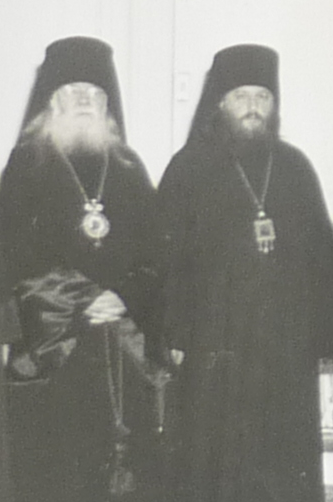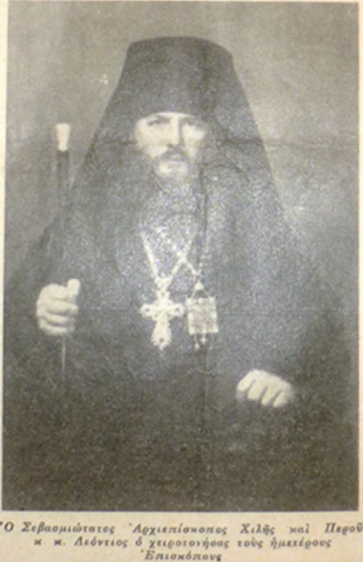Archbishop Leonty (+1971) and the Greek Old Calendarists [part 2]
(Continue from here)
Correspondence with the Old Calendarists and Preparation for a Visit to Greece
In early March 1962, Archbishop Seraphim of Chicago sent letters to Bishop Akakios of Talantion, who was ordained by him, regarding the issue of new consecrations. In his letter number 208 dated March 2nd/15th, 1962, he mentioned that he couldn't assist and wrote the following: "I highly recommend that you make an appeal to him to come to you by air to aid in further strengthening the position of your Church: Archbishop Leonty, a zealous advocate of Orthodoxy and the old calendar. He resides in Santiago, Chile, in our small diocese there. He has nothing to fear, as he governs our smaller diocese, and there is no way anyone can transfer him to a worse diocese. Therefore, the only risk he runs is the possibility of being called to account by the Synod, which is not that serious. Naturally, you will be obliged to cover his airfare and return expenses, and you will need to contribute a significant sum of money for the needs of his poor diocese. [1] His address is: His Eminence Archbishop Leonty, Patronato 446, Santiago, Chile."
In letter number 254 dated March 20th / April 2nd, 1962, he writes the following: "I inform you that I received your letter and, in response to your request, I wrote to Archbishop Leonty in Chile, and asked him to come to you (by air) and assist you. I told him that it is known to me that you have been consecrated by legitimate and canonical bishops... Let us hope that Archbishop Leonty will respond to your request and to my own, but I think he will only be able to come to you after Easter."
Meanwhile, the then Archimandrite and Protosyncellus of the Church of the Old Calendarists (and later Archbishop) Chrysostomos Kiousis maintained correspondence with Archbishop Seraphim, who also referred him to Archbishop Leonty. As Archimandrite Chrysostomos recalls about his correspondence with the latter: "I wrote repeatedly, imploring his assistance without delay, fearing that a second congestion might befall our elderly Bishop [2 ], until I received the news: 'Come, I will consecrate you.' However, the positive response did not fully satisfy us, as it was apparent that our departure measures [from Greece] would be too extreme. At that time, our prayers became even more fervent to God so that the opportunity would not be lost, and simultaneously, with stronger hopes, I continued my entreaty to the Bishop of Chile, recounting the dire measures that were preventing us from leaving. I fervently implored him to come here to prevent our second orphanhood and the additional fulfillment of the decision of the clerical assembly. [3] The venture, however, was truly challenging for him, and a just hesitation interfered with it. Nevertheless, our persistent letters gave him the courage that it would not lead to uncertainties and unrest. This was undoubtedly helped by the above information, which is why, as if by a miracle, the long-awaited letter arrived: 'Send me the ticket so I can come!!...” [4].
In March 1962, writing [5] on behalf of the Π.Θ.Ε.Ο.Κ. (P.T.E.O.K.) [6], the blessed struggler (and Secretary of the Offices of the Church of the G.O.C.) Constantine Komnios [7] wrote to Archbishop Leonty to formally invite him to our country for consecrations. Archbishop Leonty received this letter on the same day as one from Archbishop Seraphim of Chicago, who was asking him for the same thing! [8] This fact, in combination with the insight from God that Archbishop Leonty received after "earnestly praying to the Lord” [9], convinced him to come to Greece.
On March 24th (old calendar), he replied to the P.T.E.O.K., [10] requesting to know the names of the candidates to be consecrated. On the same day, he sent a brief letter to Bishop Akakios of Talantion, confidentially informing him that after Easter, he would come to Greece for the reconstitution of the Hierarchy of the Old Calendarists through new consecrations. News of Archbishop Leonty's arrival stirred enthusiasm among the ranks of Greek strugglers. This enthusiasm was shared with them (with his new letter, dated April 17/30, 1962) by Archbishop Seraphim of Chicago.
The officials of the Church of the G.O.C. sent a ticket to Archbishop Leonty, along with a letter in which they wrote, among other things, the following: "Great caution is required because the enemies are watchful. Measures have been intensified and you must come with great caution. You will appear as an ordinary monk without any distinctive vestments of an Archbishop and without a staff. After disembarking, you will attempt to identify the person whose photograph we have enclosed (he is Menegatos, [11] our taxi driver, who has our complete trust), and he will transport you to the Monastery of Bishop Akakios." [12] This letter reveals how much the potential arrival of an Archbishop had disturbed the New Calendarists, as it would have meant the re-establishment of the Old Calendarist Hierarchy, especially while the elder and ailing Bishop Akakios of Talantion was still alive.
At the same time, the P.T.E.O.K. responded [13] that the candidates for consecration are "the two Chrysostom’s, elected by two Pan-Hellenic Clerical Conferences, with the consent of the people, and without any objections being raised against it." [13]
At the same time, for the happy outcome of the issue, a five-member Committee was set up consisting of Bishop Akakios, Archimandrites Chrysostomos Naslimes, Chrysostomos Kiousis and Akakios Pappas the Younger and Constantine Komnios, as a representative of the laity. A promise of secrecy was given between them (so as not to hinder the reconstitution of Hierarchy by the enemies of the Church) and the consecrations were agreed; in a vigil immediately after the arrival of Archbishop Leonty, the consecration would take place Archimandrite Chrysostomos Naslimes, and, in a vigil the following night the consecration would take place of Archimandrite Chrysostomos Kiousis (ie of the two persons who had been elected).
NOTES
[1] This point was misunderstood by some (intentionally or not), who accused the consecrations conducted by Archbishop Leonty as being the result of simony. However, in this context, Archbishop Seraphim of Chicago speaks promptingly, emphasizing the virtue of charity, and does not impose any conditions on the consecrations. Furthermore, as we will see later, Archbishop Leonty, apart from his ticket and expenses during his stay there, received no additional funds from the administration of the G.O.C.
[2] Bishop Akakios was seriously ill at that time.
[3] Two Clerical Conferences of the G.O.C. (in 1957 and 1960) had chosen as the
first candidates to receive the rank of bishop the Archimandrites Akakios
Pappas the Elder, Chrysostomos Naslimes, and Chrysostomos Kiousis.
[4] Archbishop of Athens and All Greece (G.O.C.) Chrysostomos, My Memoirs,
Vol. 1, p. 18.
[5] The letter was not found.
[6] The Π.Θ.Ε.Ο.Κ. (in English: Pan-Hellenic Religious National Orthodox Society) was an
organization of the laity, founded in 1935 with the blessing of the Metropolitans Germanos of Demetrias and Chrysostomos of Florina, in order to support the Holy
Struggle.
[7] One of the most important and unjustly treated figures of the Struggle
(+January 18th/31st, 1992).
[8] Constantine Komnios, Speech at the 3rd Pan-Hellenic Congress of the People's
Organizations of the Genuine Orthodox Church of Greece, Athens, May 11th/12th,
1964.
[9] Letter from the P.T.E.O.K. to the Larissa Branch, dated October 5th/18th, 1965.
[10] Komnios, op. cit.
[11] Nikolaos Menegatos, later Monk Anthony.
[12] Archbishop Chrysostomos of Athens and All Greece (G.O.C.), op. cit.,
p. 19.
[13] The letter has not been found, but we know its contents from other letters.
[14] P.T.E.O.K. to the Larissa Branch, op. cit.
[Be continued].







Σχόλια
Δημοσίευση σχολίου